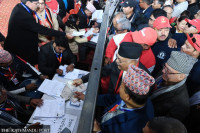National
Nepal receives just around half of the committed foreign loans
In the past five years, the government was able to claim just 30 to 54 percent of foreign loans committed by donors. Failure to spend on time and timely reimbursement blamed.
Prithvi Man Shrestha
The government received less than half the amount of total targeted foreign loans in the last fiscal year as it failed to spend resources on time to be able to claim reimbursement from foreign donor agencies.
According to the Annual Report 2020-21 of the Public Debt Management Office released early this week, the government in the last fiscal year received foreign loans amounting to Rs128.7 billion, which accounts for just 42.97 percent of the targeted loan amount for the fiscal year.
Last fiscal year is no exception in terms of the government’s inability to get the desired amount in foreign loans. In the last five years, the government has been able to receive foreign loans in the range of 30-54 percent of the annual targets, according to the Public Debt Management Office.
“The main reason behind poor progress in receiving foreign loans compared to the target is the poor spending and delay in seeking reimbursement from the donors,” said Hira Neupane, undersecretary at the Public Debt Management Office. “Even though the remaining amounts of foreign loans are received in the next fiscal year, there is no guarantee that all the budgeted foreign loans will be received because donors may decide not to provide the agreed loans once the project period is over.”
In such a case, the donors reduce the overall debt approved for Nepal, according to Neupane.
According to the annual report, Nepal received only 29.64 percent of foreign loans committed by donors in the fiscal year 2016-17 but aid receipt increased to 43.66 percent in the fiscal year 2017-18. Likewise, the aid receipts for the fiscal years 2018-19 and 2019-20 were 37.31 percent and 54.41 percent respectively of the budgetary allocations.
The lack of reliable targets for foreign loan, successive governments spending most of the annual budget in the last four months of the fiscal year and the resultant delay in getting reimbursement from donors within the same fiscal year, delay in initiating the reimbursement process, and implementation of projects without adequate preparations are among the factors responsible for the low utilisation of foreign loans, according to the report.
According to officials, the overall poor capital spending has also been reflected in the low utilisation of foreign loans. Almost all foreign loans are used either for capital spending or financing certain projects in public enterprises, and these spendings have continued to remain sluggish for long.
“Essentially, the government's failure to spend capital budget affects its ability to receive foreign loans, which are released by donors as reimbursement of expenditures already incurred on the specified projects,” said Ritesh Shakya, spokesperson at the Finance Ministry.
Particularly, in the last two fiscal years, the government’s capital spending was affected due to the Covid-19 pandemic and foreign loan utilisation during the period also remained poor,” said Neupane.
In the fiscal year 2020-21, the government spending was 72.1 percent of the total budget and capital spending was poor at just 64.7 percent. In the fiscal year 2019-20, capital spending fell to 46.3 percent owing to the strict lockdown since March 23, 2020 for nearly four months when most of the capital spending of the government takes place.
Another reason for low foreign loan utilisation is the red tape in project implementation. In the projects where foreign aid is involved, donors also get involved in monitoring, releasing the budget and in procurement. The government cannot award contracts without the approval of the donors concerned and should follow the procurement guidelines of the donors, according to officials.
“It takes more than double the time to complete the process of approval for donor-funded projects,” said Shakya. “We have to take the approval of donors in every step of the procurement process and donors take time to study our report before reimbursing expenses.”




 15.12°C Kathmandu
15.12°C Kathmandu















